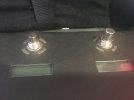Having been in the manufacturing industry, what it looks like to me is the machine used in the manufacturing of the switch parts has fallen out of spec. It happens over time and regular, (10's of thousands of parts) QC is the only way to know when it's time to either sharpen the die that is used to cast the part(s) or make the proper adjustments in order for the part to be pressed on to the proper depth.
Looking at the the switch plunger, we can see the scar mark from the switch top pressing, about a 1/16" +/-. What we don't know is if that's the proper depth.
2nd, if the ID of the switch top or the OD of the plunger are are out of spec then they wont fit according to design. If any one of these are out of tolerance the switch top can either fall off, deform or crack in the pressing process.
I still think that a small dot of an epoxy based adhesive like JB Weld would be the easiest fix short of sending the unit to FAS to have the switch changed out.
View attachment 134710

